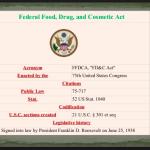It's not a secret that the average person is scientifically illiterate. The question is, "Just how scientifically illiterate?" The answer is appalling.
chemicals
By Dr. Michael Dourson and Dr. Bernard Gadagbui
Obesity. It's a big fat problem. And, as with all big fat problems, somebody else is to blame.
A recent New York Times editorial "Cosmetics Safety Needs a Makeover" calls for better FDA regula
By Dr. Jenifer Heath
Perfluorooctanoic acid (PFOA) is a chemical commonly found in household products. Its purpose is to resist stains, grease, and other assaults.
The New York Times has done something that it very rarely does: It wrote an editorial in support of biotechnology.
Two weeks ago, we reported on a bizarre decision by the online news arm of the journal Science: The outlet had reprinted an article
The online news arm of the journal Science is a solid source of information. However, recently it made a very strange editorial decision that could potentially harm its reputation.
There can be no better example of the damage done by quackery masked as "alternative medicine" than the tragic case of Chad
NYT's Nicholas Kristof sure knows how to live harder, not smarter. He's been avoiding chemicals and living clean — as he puts it — for several years.











